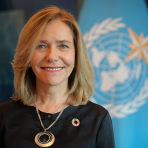Statement on the occasion of the 25th anniversary of the Geneva Environment Network
Thank you for inviting me. Congratulations on the 25th anniversary of the Geneva Environment Network. WMO is also marking a big birthday this year – 75 years as a specialized agency of the United Nations.
Today the need to forge stronger environmental action through science is more urgent than ever. As we say repeatedly, the climate crisis is linked with the inequality crisis and is interlocked with other planetary crises including biodiversity loss and pollution.
Climate change does not have a four or five year term in office and does not respect national interests or geopolitics. It follows the laws of physics and these are non-negotiable. It is the defining challenge for humanity.
During my first year as Secretary-General of the World Meteorological Organization, I have repeatedly issued the Red Alert about the State of the Climate.
We are, unfortunately, living through climate history.
As you know, WMO has confirmed that 2024 was the warmest year on record and for the first time temporarily exceeded 1.5 °C above the pre-industrial level. To be precise, it was 1.55 °C above preindustrial level, according to WMO’s consolidated analysis of six international datasets.
The past ten years are the hottest ten years on record.
Sea surface temperatures and ocean heat are at record levels and, in 2023 and 2024, drove the extraordinary global heat.
To put this into perspective, the increase in ocean heat content in just the upper 2000 meters of the ocean between 2023 and 2024 was roughly 140 times the total electricity generated worldwide in a year.
This illustrates the immense amount of heat the oceans are absorbing and the urgency to address climate change.
Why does it matter?
It is important to emphasize that a single year of more than 1.5°C does NOT mean that we have failed to meet Paris Agreement long-term temperature goals, which are measured over decades.
An international team of WMO experts has given an initial indication that long-term global warming is currently about 1.3°C compared to the pre-industrial baseline.
The Paris Agreement may not yet be dead. But it is in urgent need of the kiss of life.
Science tells us that every fraction of a degree of warming matters. Every fraction increases cascading hazards. It increases environmental, human and economic losses.
It means more intense heatwaves, heavier rainfall and more rapidly intensifying tropical cyclones.
It means accelerating sea level rise, ocean heating, ocean acidification and more ice and glacier retreat.
Tomorrow, on 21 January, WMO and UNESCO will launch the International Year of Glaciers’ Preservation. This will highlight the need for stronger environmental action informed by science.
There are more than 275,000 glaciers worldwide. Together with ice sheets, they store about 70% of the global freshwater.
In 2023, glaciers suffered the largest mass loss in five decades of record-keeping – as we saw with record losses in the Swiss Alps.
Glacier retreat – just like sea level rise – is irreversible on timescales of centuries to millennia. This is according to the Intergovernmental Panel on Climate Change, which is co-sponsored by WMO and UNEP.
Everyone here today will agree that we need urgent and sustained cuts in greenhouse gas emissions. These must be informed by science. This rationale underpins the Global Greenhouse Gas Watch initiative now being rolled out by WMO and partners.
Science should inform climate adaptation and life-saving early warnings.
Science must also inform solutions.
Renewable energy is just one example. We need innovation and political will to meet the ambitious target to triple installed renewable energy capacity by 2030.
We are making progress but need to go further and faster.
However, climate change is also challenging our capacity to produce cleaner energy. It has significant impacts on generation and demand for renewables such as wind, solar and hydropower.
We therefore need scientific tools to anticipate these fluctuations in order to meet collective climate, environmental and sustainable development goals.
I would like to conclude with an inspiring example of how science has guided environmental policymaking and played a key role in monitoring its success.
It is the ozone layer.
When scientists discovered that the ozone layer was thinning over Antarctica, it sparked global action. This led to the creation of the Vienna Convention and the Montreal Protocol, agreements that phased out nearly 99% of harmful chemicals that were damaging the ozone.
The most recent scientific assessment from UNEP and WMO show that the ozone layer is on track to recover within four decades. The phaseout of ozone-depleting chemicals has the added bonus of boosting efforts to mitigate climate change.
The Montreal Protocol is a true champion for the environment.
It sets a precedent for climate action. It shows that scientific knowledge, technological advances and political will can join as powerful forces for good for the environment and the planet.
The Geneva Environment Network was set up 25 years ago when there were already clear warning signals about climate change. We ignored them. We lost a generation of action.
We have the knowledge. We have the tools. Let us finally use them to turn the corner in 2025.
Statement by


